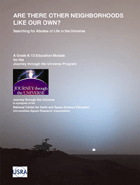 Are There Other Neighborhoods Like Our Own? Searching for Abodes of Life in the Universe is one of several Education Modules developed for the Journey through the Universe program. Are There Other Neighborhoods Like Our Own? Searching for Abodes of Life in the Universe is one of several Education Modules developed for the Journey through the Universe program.
The Module focuses on the search for abodes of life in the universe. Considering that life is found in just about every environment on Earth—from frozen Antarctica to sun-deprived hydrothermal vents at the bottom of the ocean to the interior of nuclear reactors—life flourishes over a wide range of environs. If it is conceivable for species to adapt to living conditions that are unthinkable for human survival, then similar adaptations might be possible for life on another world. Mars, with frozen water beneath its surface, and Jupiter’s icy moon Europa, may seem like harsh environments to us, yet they may be abodes of life. The storyline approach adopted for this Module is to address three questions at each grade level: - What makes our neighborhood an abode of life, and might these conditions be present in other neighborhoods beyond our own?
- Why do we want to search for other neighborhoods like our own?
- How will we explore other neighborhoods beyond our own?
Each grade-level Education Unit has a lesson addressing each of these questions. At the elementary level ‘our neighborhood’, a case study of a familiar life-bearing environment, is one’s hometown and ‘other neighborhoods’ are other possible abodes of life within the Earth-Moon system. At the middle school level ‘our neighborhood’ is the Earth-Moon system and ‘other neighborhoods’ encompass those found across the Solar System. At high school ‘our neighborhood’ is the Solar System as an abode of life, and the search for ‘other neighborhoods’ spans the entire galaxy. The nature of a neighborhood at each grade level is based on the National Science Education Standards and Benchmarks for Science Literacy. The Module contains activities at three grade levels (K-4, 5-8, 9-12). Each grade level package is called an Education Unit. The Module also includes one Family and Home activity, and one activity on the Process of Science, both of which are suitable for use at all grade levels. Note that the Module currently uses an old lesson format. |
Grade K-4 Unit, Lesson 1: My Hometown (PDF, 712 KB)
In this lesson, students critically think about what resources are needed for survival, and where these resources can be found. First, students define the essential resources needed for survival by considering themselves on an isolated island, far from the comfort and familiarity of their own neighborhood. Through discussion, they distinguish the non-essential needs—TV, refrigerator, car, etc.— from the essential—water, food, shelter (a reasonably comfortable environment), and air, and recognize tools that can be used to secure essential needs—sharp stick, fishing line, etc. They then build a three-dimensional model of their own neighborhood—their home and extended community—and identify where the essential resources are found. Grade 5-8 Unit, Lesson 3: Searching for Signs (PDF, 684 KB)
Students are presented with three soil samples representing simulated Martian Soil. After visual inspection of the soil samples they ‘feed’ the samples with nutrient solution and assess if this causes any observable activity. They then explore the nature of the observed activity and determine if it represents chemical or biological processes. The lesson is a direct analog to the life science experiments conducted by the Viking Landers on the surface of Mars in 1976 to look for photosynthesis, respiration, and gas exchange. The nature of the observed activity on Mars, once soil samples were fed ‘chicken soup’, allowed researchers to distinguish with high confidence between chemical and biological processes at the landing sites. Grade 9-12 Unit, Lesson 3: Sending Messages (PDF, 728 KB)
In 1974, the Arecibo Radio Observatory in Puerto Rico sent a message into space toward the Globular Cluster M13 in Hercules. The message included information about the human race and our planet, and used the physics and chemistry of the universe as the common language through which extraterrestrials could decipher the message. In this lesson students will be provided the message, attempt to interpret it, and gain a good understanding of the challenges of communicating with other intelligent life in the galaxy. |
